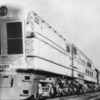1)Did they ever think of diesel direct drive locomotives rather than diesel-electric? I understand why they went with the diesel-electric mode (multiple unit control, which Frank Sprague developed in the late 1800's, meant that you could control all the engines in a multi unit set, it already was working long before the diesel came about on subways and multi unit trolleys and interurbans). Just wondered if anyone worked on them or actually produced them; I understand why they never made it, of course.
2)Did anyone ever work on, or at least propose, a steam-electric kind of engine? Not sure that it is even possible, I don't know if you can have a demand regulator that you can with a diesel or gas engine where it revs the engine in response to more demand; the other issue might be the need to have a fireman in all the engines, either to feed the fire or simple as a safety in case something goes wrong there. Obviously, if they did it wouldn't be very practical, especially once the diesel engine had been perfected, but just curious.










